Wednesday 11 February 1942
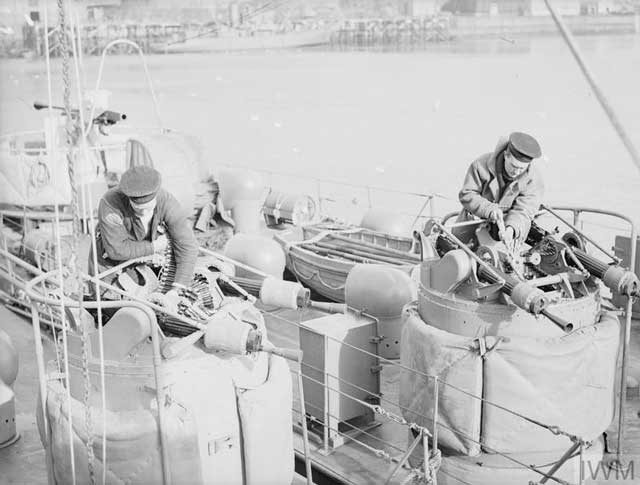 |
| "Gunners cleaning the 0.5" VMG guns aboard a C class MGB." Royal Naval Coastal Force, Dover, 11 February 1942. © IWM (A 7453). |
Battle of the Pacific: At Singapore on
11 February 1942, things on the ground are only going from bad to worse for the Allies. The British command is confused and its troops overwhelmed as the Japanese advance into the center of Singapore Island. At 03:00, the Japanese 18th Division destroys the Australian "X" battalion west of Bukit Timah and continue through the village. The Japanese 5th Division also takes Bukit Panjang. The Australian 22nd Brigade, which has been fighting a harrowing rearguard action all the way from the beaches, now is virtually out of action due to massive losses.
 |
| Detail of a map of fighting on Singapore on 11 February 1942. It shows the fighting flowing from west to east along Jurong Road. There is a Japanese attack at 03:00 west of Bukhit Timah (red at left). Later, Tomforce digs in east of the town later in the day (at the right). |
Bukit Timah is desperately important to the British because it controls the island's water supplies. "Tomforce" of the Australian 27th Brigade (Lt. Colonel L.C. Thomas) is ordered to retake Bukit Panjang as part of a phased counteroffensive to later retake Bukit Timah and the water reservoir. However, the 5th and 18th Japanese Imperial Infantry Divisions beat them back. Tomforce, shattered, then adopts a defensive posture on either side of the Bukit Timah Road. At this point, though, with the Japanese in control of the water, defending is not enough for the British to hold the island for long.
 |
| Overall map of fighting on Singapore during 11 February 1942. The fighting around Bukhit Timah is in the lower center. |
In the afternoon, Japanese commander General Tomoyuki Yamashita issues a surrender demand, asking the British to "give up this meaningless and desperate resistance." The British do not reply. General Archibald Wavell, commander of American-British-Dutch-Australian Command, orders Lieutenant-General Arthur Ernest Percival, Singapore's commander, to fight to the end and not surrender. Percival's strategy now becomes to form a line around Singapore City itself at the eastern end of the island. British 15-inch artillery at Changi, on the island's east coast, turn 180 degrees and begin firing at targets in the Bukit Timah area. However, their effectiveness is reduced because they are armor-piercing shells designed to fire at naval targets. For all intents and purposes, the battle for Singapore is lost on 11 February 1942.
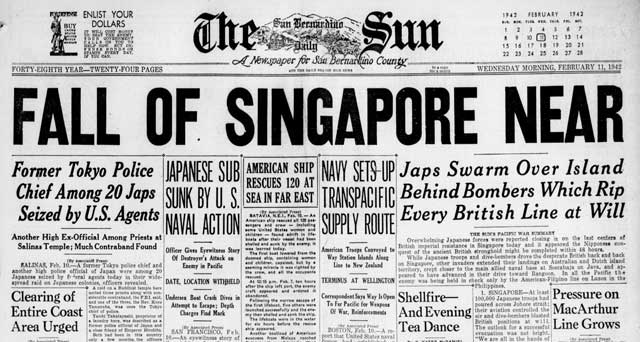 |
| The San Bernardino, California, Daily Sun correctly predicts the future, 11 February 1942. |
On the Bataan Peninsula, the Philippines, the US Army I Corps in the western half of the peninsula makes good progress against trapped Japanese forces south of the Main Line of Resistance (MLR). This is known as the "Big Pocket." Some Japanese troops escape through a gap in the lines to the north. Farther south, other trapped Japanese forces at Silaiim Point also lose ground.
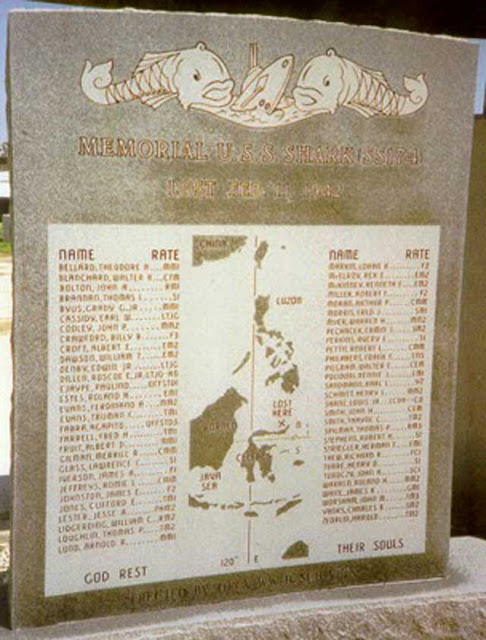 |
| The USS Shark memorial in Muskogee, Muskogee County, Oklahoma. |
United States Navy submarine USS Shark (SS-174) disappears around this date. It is likely but not positive that Japanese destroyer Yamakaze sinks the submarine using 5-inch (130mm) gunfire about 120 miles east of Manado, North Sulawesi, Netherlands East Indies. There are no survivors from the 58-man crew.
The Royal Australian Air Force sends three Hudsons to attack shipping at Gasmata, New Britain, Papua New Guinea. They sink two transport ships. Defending A6M4 Claudes of the Chitose Kokuta shoot down two of the Hudsons.
In Burma, Japanese troops in small groups have been quietly crossing the Salween River, which the British are using as their main defensive line. Today, some of these Japanese troops near Paan trap a battalion of the Indian 46th Brigade near Sittang, Monywa. They attack in darkness using only bayonets that have been covered in mud so as not to reflect light. The Japanese shoot the wounded British commanding officer, a Lieutenant Colonel, in his tent along with several other men with him after - Japanese soldier Captain Tadashi Suzuki (Gun Company, 215 Infantry Regiment, 33 Division) later claims - he asked to be shot. Suzuki notes that the Colonel "died in a serene frame of mind."
Eastern Front: Who exactly remains on the offensive on the Eastern Front remains murky. The Wehrmacht has been reestablishing communications to its trapped units in the east at the same time that the Red Army is still on the move to the west. Recognizing that things have stalled, the Stavka now orders the 3rd and 4th Shock Armies of the Kalinin Front to resume their advance south of Lake Ilmen on 12 February. The plan is to tighten the Red Army's grip on the Demyansk Pocket and, once it is further isolated, attack it directly.
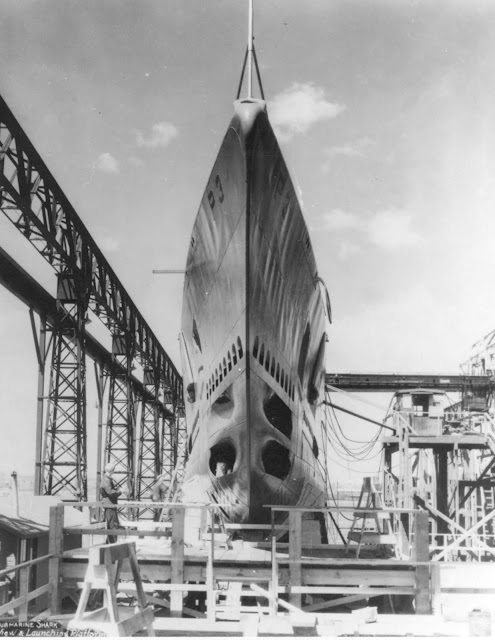 |
| This is a nice clean photo of the bow of USS Shark SS 174, sunk on 11 February 1942. This photo was taken on May 20, 1935. The Shark was launched the next day from Electric Boat in Groton, Conn. Photo provided by SN (SU) Alan A Palmer, USN whose uncle was aboard when Shark was sunk (NavSource Online). |
European Air Operations: The RAF sends 49 aircraft to bomb Mannheim, Germany. No planes are lost. Another 25 Wellington bombers and 6 Whitleys attack Le Havre. The RAF loses on Wellington in this raid. RAF Bomber Command sends 18 Wellington bombers over Brest around 19:00, losing one Wellington. While the Brest raid does not cause much damage due to cloudy conditions, it does cause a three-hour delay in the departure of the large German ships involved in the Channel Dash.
During the day, RAF Douglas Boston III bombers of RAF No. 88 Squadron attacks shipping. This is the first action by these planes. In other missions, five planes drop leaflets on Occupied France, and a Manchester bomber is sent on a minelaying operation in the Frisian Islands.
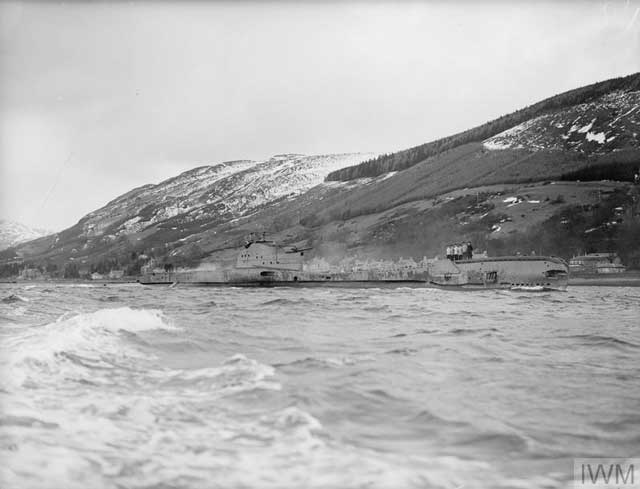 |
| "HMS TALISMAN [is] seen arriving at port." 11 February 1942 at Holy Loch. © IWM (A 7823). |
Battle of the Atlantic: At 22:45 on 11 February 1942, three large German warships escorted by six destroyers quietly leave Brest Harbor. These are heavy cruisers Scharnhorst, Gneisenau, and Prinz Eugen. Their departure has been delayed from 19:30 by an RAF bombing raid, and this turns out to be a fortuitous delay for the Germans because submarine HMS Sea Lion, which has been positioned off Brest to watch for just such an occurrence, ended its watch at 21:35. The Germans also jam radio transmissions, which prevents a British spy in Brest from warning of the departure. It is a cloudy night with a new moon, and a nearby RAF spotter plane equipped with radar fails to spot the ships. Thus the German convoy evades detection and steams off into the night, heading for the English Channel. This is the beginning of Operation Cerberus, more commonly known as the Channel Dash.
 |
| Norwegian freighter Heina, sunk by U-136 on 11 February 1942. |
U-136 (Kptlt. Heinrich Zimmermann), on its first patrol out of Bergen, has a big day in the North Atlantic south of Iceland. While shadowing Convoy SC-67, it fires four torpedoes between 01:33 and 01:35. They sink two ships: 4028-ton Norwegian freighter Heina and 925-ton Canadian corvette HMCS Spikenard (K 198). There are 57 deaths on the Spikenard and eight survivors. The search is hampered because nobody on other ships notices the Spikenard sinking, so her loss is not even noticed until after dawn. Everybody on the Heina survives.
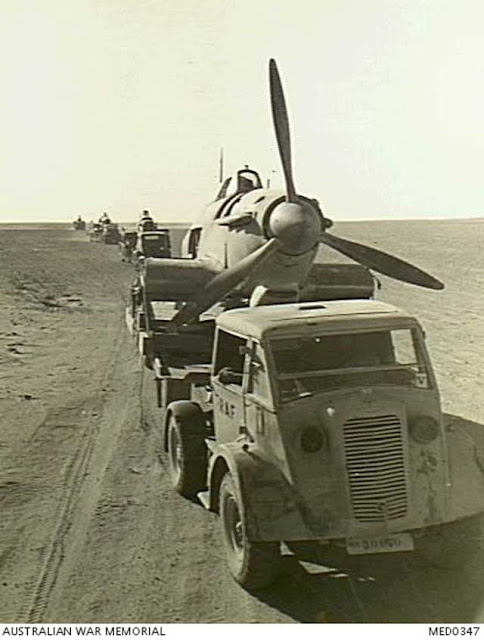 |
| "Western Desert, Libya. 11 February 1942. Personnel of Repair and Salvage Units travel long distances to recover damaged Hurricane Mk II aircraft assessed as suitable for repair and load these onto 'Queen Mary' vehicle tenders for return to the unit workshop in the Cairo area with the return journey often taking several days. Off again! RAF vehicle, WD30670, is in the lead of the convoy of five vehicles. The desert surface combines jagged rocks, soft sand drifts, often churned to deep mud. Wear and tear on tires and chassis is probably the world's worst." Australian War Memorial MED0347. |
Battle of the Mediterranean: Before dawn, an Axis air attack hits destroyer HMS Maori in Grand Harbor, sinking it (this sinking is sometimes dated as occurring on 12 February). There are only six deaths (some sources say only one) because most of the crew is sleeping ashore. After daylight, Luftwaffe Junkers Ju 88 bombers approach Grand Harbor on Malta just as several Royal Navy ships are entering. They hit cruiser HMS Cleopatra with a 500 kg bomb, causing 20 casualties in the bow area. Later in the day, Blenheims of RAF No. 21 Squadron, based at Luqa, are attacked by fighters as they return to base after an anti-shipping sweep and lose one plane.
 |
| Lieutenant André Bloch, executed as a spy on 11 February 1942. |
Spy Stuff: André Bloch, a French agent of the SOE, is executed at Mont Valerien. He will become the first victim honored from section F at the memorial Valençay.
 |
| The USS Juneau In New York Harbor, 11 February 1942. Courtesy the U.S. National Archives. |
US/Vichy French Relations: U.S. Ambassador to Vichy France Admiral William D. Leahy, USN (Retired), warns the Petain government not to use French ships to ferry Axis men or material to North Africa. He states that he will be recalled if Vichy French ships are used for such missions to Tunisia. Despite having entered the war in December 1941, the United States continues to play a very delicate game in Europe with both Vichy France and Finland. It is not at war with either of them, and both wish to remain at peace with the United States. However, both the French and the Finns remain under extraordinary pressure to provide support to Axis operations which the Americans feel are acts of aggression against the Western powers. So far, both Finland and France have resisted that German pressure, though it is increasing steadily.
 |
| HMCS Spikenard (K198), sunk by U-136 on 11 February 1942. |
US Military: USAAF Fifth Air Force completes a transfer of nine P-40s from Darwin, Australia, to Blimbing Airdrome, Java, via Timor Island. Another eleven 5th Air Force A-24s depart today for a similar transfer from Darwin.
Admiral Hart steps down as the commander of Allied Naval Forces in the Southwest Pacific. He is succeeded by Vice-Admiral Helfrich, Dutch Naval Commander-in-Chief in the Pacific.
The 303rd Bombardment Group (Heavy), activated on 3 February 1942 at Pendleton Field, Oregon, assembles at Gowen Field, Idaho for training.
Australia: The government stages an unannounced blackout in Sydney and is displeased with the results. It counts 822 violations of the blackout. This compares unfavorably with a similar test on 14 January 1942 when 707 violations were spotted. This may be an indication that the panic associated with the beginning of the Japanese invasions is easing slightly.
Canada: There are riots in Montreal regarding conscription plans that involve sending soldiers overseas. The protesters believe that this violates the previous government policy of not sending home defense troops overseas. The protesters adopt for themselves the term "Zombies," which has been used by the public in a disparaging fashion for these men who are considered to be of a lesser caliber than regular army troops.
 |
| USS Shark, sunk on 11 February 1942 (USN photo # 80-G-456140 via Navsource). |
February 1942
February 1, 1942: The US Navy Strikes Back
February 2, 1942: Germans Recovering in Russia
February 3, 1942: Japanese Shell and Bomb Singapore
February 4, 1942: Battle of Makassar Strait
February 5, 1942: Empress of Asia Sunk
February 6, 1942: The Christmas Island Body
February 7, 1942: The Double-V Campaign
February 8, 1942: Japan Invades Singapore
February 9, 1942: French Liner Normandie Capsizes
February 10, 1942: US Car Production Ends
February 11, 1942: Tomforce Fails on Singapore
February 12, 1942: The Channel Dash
February 13, 1942: Japanese Paratroopers In Action
February 14, 1942: RAF Orders Terror Raids
February 15, 1942: Japan Takes Singapore
February 17, 1942: Indian Troops Defect to Japanese
February 18, 1942: Battle of Badung Strait
February 19, 1942: FDR Authorizes Internment Camps
February 20, 1942: O'Hare the Hero
February 21, 1942: Crisis in Burma
February 22, 1942: Bomber Harris Takes Over
February 23, 1942: Bombardment of Ellwood, California
February 24, 1942: US Raid on Wake Island
February 25, 1942: Battle of Los Angeles
February 26, 1942: Gneisenau Eliminated
February 27, 1942: Battle of Java Sea
February 28, 1942: Battle of Sunda Strait
2020













No comments:
Post a Comment